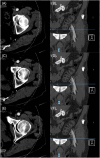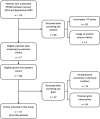Investigating the effects of percutaneous endovascular aneurysm repair for abdominal aortic aneurysm on the lumen size of the common femoral artery
- PMID: 39254910
- PMCID: PMC11387579
- DOI: 10.1186/s42155-024-00476-0
Investigating the effects of percutaneous endovascular aneurysm repair for abdominal aortic aneurysm on the lumen size of the common femoral artery
Abstract
Background: Percutaneous endovascular aneurysm repair (PEVAR) is the definitive therapy of choice for abdominal aortic aneurysms worldwide. However, current literature regarding the anatomic changes in the common femoral artery (CFA) post-PEVAR is sparse and contradictory, and a significant proportion of these studies did not control for the potential confounding effects of ethnicity. Thus, this study aims to investigate the anatomical effects of PEVAR on the CFA using an Asian study cohort.
Methods: Between January 2019 and September 2023, the records of 113 patients who received PEVAR were reviewed. Groins with previous surgical interventions were excluded. The most proximate pre- and postoperative CT angiography of patients receiving PEVAR via the Perclose ProGlide™ Suture-Mediated Closure System were retrospectively analysed for changes in both the CFA inner luminal diameter (ID) and outer diameter (OD), the latter also encompassing the arterial walls. Access site complications within 3 months post-PEVAR were also recorded per patient.
Results: One hundred seventeen groins from 60 patients were included in this study, with 1 report of pseudoaneurysm. The CFA ID exhibited a 0.167 mm decrease (p-value = 0.0403), while the OD decreased by 0.247 mm (p-value = 0.0107). This trend persisted when the data was separately analysed with the common cardiovascular risk factors of diabetes mellitus, hypertension and hyperlipidaemia.
Conclusion: Our analysis demonstrated a statistically significant decrease in the CFA diameters post-PEVAR. However, the percentage changes were below established flow-limiting values, as reflected by the single access site complication reported. Hence, our findings give confidence in the safety profile of this procedure, even with the reported smaller baseline CFA lumen size in Asians. Moving forward, similar longer-term studies should be considered to characterise any late postoperative effects.
Keywords: Abdominal aortic aneurysm; Common femoral artery; Inner diameter; Outer diameter; Percutaneous endovascular aneurysm repair; Surgical outcomes.
© 2024. The Author(s).
Conflict of interest statement
The authors declare that they have no competing interests.
Figures


Similar articles
-
Common Femoral Artery Caliber Changes after Percutaneous versus Surgical Access in Endovascular Aneurysm Repair in the Asian Population.Ann Vasc Surg. 2018 Feb;47:266-271. doi: 10.1016/j.avsg.2017.09.005. Epub 2017 Sep 22. Ann Vasc Surg. 2018. PMID: 28943488
-
A multicenter, randomized, controlled trial of totally percutaneous access versus open femoral exposure for endovascular aortic aneurysm repair (the PEVAR trial).J Vasc Surg. 2014 May;59(5):1181-93. doi: 10.1016/j.jvs.2013.10.101. Epub 2014 Jan 17. J Vasc Surg. 2014. PMID: 24440678 Clinical Trial.
-
Short-term outcome and mid-term access site complications of the percutaneous approach to endovascular abdominal aortic aneurysm repair (PEVAR) after introduction in a vascular teaching hospital.Cardiovasc Interv Ther. 2019 Jul;34(3):226-233. doi: 10.1007/s12928-018-0547-4. Epub 2018 Sep 26. Cardiovasc Interv Ther. 2019. PMID: 30259385
-
Current Status of Percutaneous Endografting.Semin Intervent Radiol. 2015 Sep;32(3):278-88. doi: 10.1055/s-0035-1556826. Semin Intervent Radiol. 2015. PMID: 26327747 Free PMC article. Review.
-
Endovascular stent grafting and open surgical replacement for chronic thoracic aortic aneurysms: a systematic review and prospective cohort study.Health Technol Assess. 2022 Jan;26(6):1-166. doi: 10.3310/ABUT7744. Health Technol Assess. 2022. PMID: 35094747
References
LinkOut - more resources
Full Text Sources
